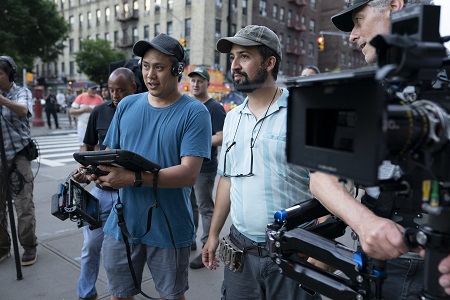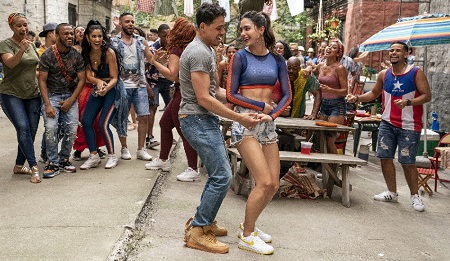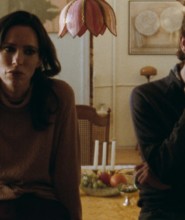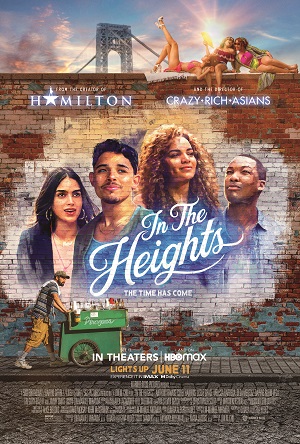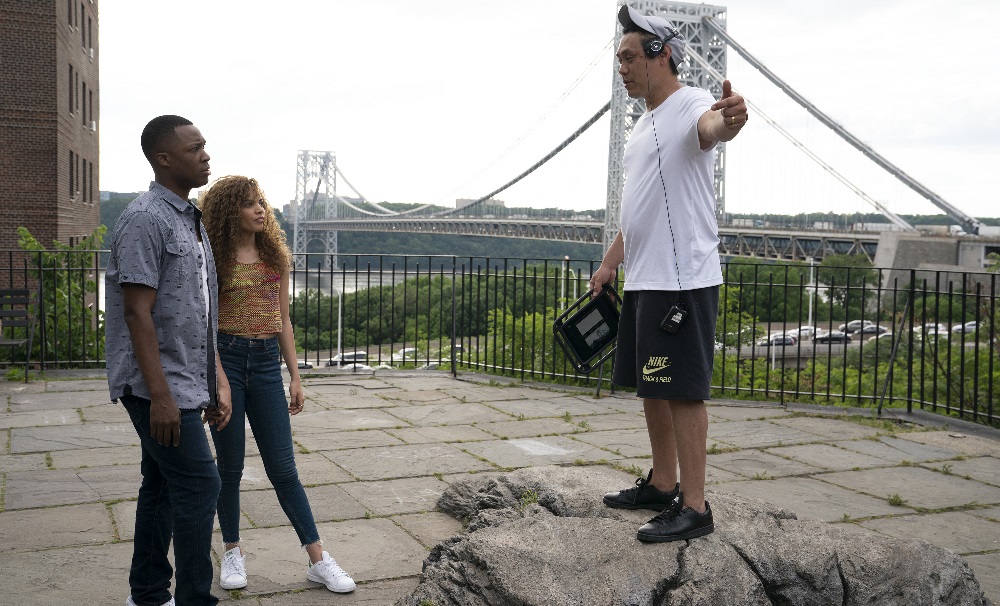
“In the Heights” – Interview with Jon M. Chu
by Sara Michelle Fetters - June 10th, 2021 - Interviews
Dancing in the Streets
Director Jon M. Chu on adapting In the Heights for the big screen
The Broadway smash In the Heights is a joy-filled musical celebration set in New York City’s Washington Heights neighborhood and centered on a local bodega run by Usnavi de la Vega. Tired of the gentrification of his neighborhood and the hustle and bustle of the big city, Usnavi is a dreamer who longs to go to the Dominican Republic and rebuild his family’s old beachfront store.
Over the course of two-plus hours he and several other residents of Washington Heights will learn a number of important lessons about community, family and togetherness. As written and conceived by Lin-Manuel Miranda and Quiara Alegría Hudes, it is a timeless story overflowing with music, dance, and authentic human emotions. The original theatre production earned 13 Tony Award nominations in 2008, winning four, including Best Musical.
Director Jon M. Chu’s adaptation is a rambunctious, high-energy treat that in some ways couldn’t be hitting cinemas at a more opportune time. It’s story of hope and humanity is a cathartic shot in the arm, and it’s hard to imagine a more communally joyous experience for audiences than what this ends up proving to be.
I sat down with Chu over Skype to discuss In the Heights. Here are a few edited excerpts of what he had to say:
Sara Michelle Fetters: What was it about In the Heights that inspired you? What was it about this Broadway musical that made you want to make this film?
Jon M. Chu: I was shooting my first movie, Step Up 2: The Streets, so it was years ago. I’d never heard of this guy, Lin-Manuel Miranda. But I went, not knowing what to expect.
It just rocked my foundation. I saw my family in it, even though I’m not from Washington Heights and I’m not Latino. I’m an Asian dude from the Bay Area, from California, and I grew up in a Chinese restaurant. And yet, I knew who exactly who Abuela Claudia was in my life. I knew exactly what it felt like to have struggles, to have the dreams and the hopes of your family. I knew what it felt like to disagree with my brothers and sisters. I knew what it felt like to see things that my parents may not have seen and struggled with. It just said everything to me that I had never been able to express myself, even as a filmmaker.
So it stayed with me. When the opportunity came, when Mara Jacobs and Scott Sanders, the producers, came to me and I got to meet with Lin, I talked to them about this stuff, about the dreams and the hopes that I would have that were bigger than my bedroom wall or any restaurant could ever hold. I think we all saw the same.
SMF: What was that relationship like between you and Lin-Manuel during the production? Did he offer input or was he more hands-off and let you do your own thing?
JC: He was busy with Hamilton when we were developing the film. During development, me and Quiara Alegría Hudes were sort of two peas in a pod. Quiara is his proverbial neighbor, so she would check in with him about what we were doing and any changes we were making.
Lin was totally cool. Could not have asked for a better partner to understand that film is different and give us the freedom to do our own thing.
When we started casting, that’s when Lin started to see what we were doing and get involved. That was great. He has such insight.
When we were shooting, I didn’t know how much he would be around. But we were in his backyard. He came almost every day just to hang out. I think he enjoys people and he enjoyed our company. Lin is a great friend, and I couldn’t ask for a better example of how I want to be as a creative leader.
SMF: As you just mentioned, there is a difference between a Broadway production and film. There are some things that a Broadway production might do better than a film and vice versa. When you’re working on an adaptation like this, what do you leave out? What balance do you try to strike between keeping the vibe and the energy of the Broadway production and still making it cinematic?
JC: I kind of had to deconstruct the idea of translating and instead go back to the roots of the music and why a musical exists in the first place. Why is music more expressive? When words aren’t enough, for many things music can speak with a more powerful voice. A paragraph of dialogue transformed into a dance. I had done a lot of dance work before this and I already knew how that could tell story, so that’s where I started.
SMF: In that vein — and you know this better than almost any director, through Step Up 2 and all the other dance movies and concert films you’ve done — there is a relationship between performance, cinematography and editing that is key to making a successful musical. It’s vital in every film, of course, but it seems that’s even more the case when making a motion picture like this one.
What input do you take from the cast? Or from your cinematographer, Alice Brooks, or your editor, Myron Kerstein? When you’re assembling all of these pieces, what is that relationship like with your collaborators that ensures you capture that energy on the screen, that you don’t lose any of it by overcutting or shooting at the wrong angle?
JC: We’re a family. It’s definitely a total team effort. I’ve worked with Alice since school. This is our first big musical together. But we’ve done tons of dance stuff. We’ve made a lot of mistakes in the past which we’ve learned from. She’s a fellow storyteller.
I think that’s what I value most of my crew and my cast. They’re all storytellers, and they all paint in a different medium than I do. It’s our collaboration that counts. It’s our process that matters. I’m saying to Christopher Scott, our choreographer, that I’m trying to get the scene to be about a character’s isolation and I want to know what movement communicates that. And he comes up with it. And the dancers execute it. It’s collaboration.
Same goes for other aspects of the production. I’d go to Nelson Coates, our production designer, and he creates a set that is as functionally busy as a real bodega but is as specific as a map on the wall made out of subway tiles, keys and product labels from the bodega itself. I can’t tell him to do that. He just does it.
The cast would say, “This is not the sauce that we would have at a dinner,” and then someone would make their own homemade sauce. Someone else would add, “Food isn’t served like this” or “This dish would be on the side,” and we’d make sure the dinner is presented in that fashion. Someone even asked about that big old spoon every family always has, and someone went out and found a perfect one that we could utilize in the scene. We just made room for these conversations. We were all storytellers together.
SMF: There is something extraordinary in seeing these lives and these characters get their own showcase in a major motion picture. I think what you’re talking about only feeds into that. I mean, personally, watching films like A Fantastic Woman or Tangerine, I know how much seeing lives that even tangentially looked like mine meant to me.
I went back and I looked at your movies, and it seems as if you have made it a priority to assemble these extraordinarily diverse casts. More importantly, with varying degrees of success, it feels as if you manage to get into many of their stories in one way or another. Why has this been important to you? How does it make you feel to now be able to do this on an even larger scale with Crazy Rich Asians and now In the Heights?
JC: I think any artist from a marginalized community knows this is our reality. This isn’t something that we’re just making up along the way. These are our friends. This is our family. This is how we see the world.
I jumped into making studio movies. I didn’t do independent movies or other things before that. I went big into the studio system right away. In a weird way, you could say I was raised by that system. It only makes sense then that I’d put a little of myself and my own cultural journey into the stories I’ve been lucky enough to tell.
The greatest story we’re going to tell is the one we’re crafting for our children. What is America to them? What world are we creating for them? What does acceptance mean to them? That’s just become more of a priority for me over time. It’s like I woke up one morning and realized that were was nothing holding me back from telling stories with all those questions and more in mind.
SMF: How important was it to have Olga Merediz back from the Broadway production portraying Abuela Claudia? Also, are you planning on supplying theaters showing the movie with tissues for the “Alabanza” number? Because I died. I was dead. I was drowning in tears during that number. You killed me.
JC: You should have been there when Olga sang it for the first time in the audition. She came in and she wasn’t Olga. She came in as Abuela Claudia. I don’t think I’ve even met Olga. Even the day before shooting, when we had a dinner party, she was always Abuela Claudia. She is Abuela Claudia.
When she sang that song in rehearsal, everyone was in tears. We purposely made sure that number was not about the dancing. Everything needed to happen around her, close up. We wanted to make sure we were not taking attention away from Abuela Claudia. She is driving the whole damn thing during that number.
The thing is, if that scene were just her on the couch it would be just as powerful. You would cry the same. For that scene, it was me getting out of the way in order to allow Olga to soar. She is just that much of a force.
SMF: What was the overall casting process like?
JC: I’ve learned a lot of lessons in my career, especially from Crazy Rich Asians. When you take the time to task, when you search in the places that the Hollywood system has not allowed people of color to be in, you get pick of the litter because there’s just that much untapped talent. It is not because there’s a lack of talent. It’s a lack of access. Thank God Warner Brothers understood that.
I mean, Anthony Ramos, he’s such a poet. And Leslie Grace, it’s her first movie. How is that possible? And Corey Hawkins. He’s a trooper. So versatile and willing to do anything. And then there’s little Gregory Diaz. He’s just 14-years-old! And he just kills it! We put him into the mix and everyone just became so protective of him. It was great to see.
And, of course, there’s Melissa Barrera, who probably I saw grow the most. She came in and had to find the wounds of this character. She had to find Vanessa. Because Melissa is so bubbly and kind, and this role required so much of her. She had to search deep down while also having to learn how to dance. Melissa was fully vulnerable and exposed, but she just hit it out of the park. The whole cast did. Every member. I’m just so proud of all of them.
SMF: What do you hope audiences take away from this film? Now that we can see the light at the end of the tunnel, In the Heights is one of the first big films where people are going to have a chance to see it together in theaters, anywhere from 50 to 75% capacity, maybe more than that in some instances. What do you want them to take away from this experience? What do you hope that they’re talking about, and what does it mean to you that this film by all appearances seems to be opening just when it’s maybe needed the most?
JC: It’s interesting. When you see a community like Washington Heights which has learned how to survive, how to pick one another up, that has been there for one another, you realize these are truthful, timeless ideas. The joy you have to exalt. The beauty you have to be able to see beyond the struggles which are right in front of you. These are assets and tools that communities have used throughout time to get through difficult situations.
In a way, the world in this past year has gone through the most isolating, difficult time imaginable. What better guides out of the darkness and back into the light than the people of Washington Heights? I want audiences to come out feeling healed. I want them to feel joyful. I want them to feel excited and curious. I want them to listen to more of that music. I want them dancing. I want them to want to know how to learn the dances that they see performed. I want people to want to meet and mingle and make new friends again.
I think people are ready, and our In The Heights greeting committee is ready and waiting for them. I want them to get our vaccine for the soul.
– This interview reprinted courtesy of the SGN in Seattle
